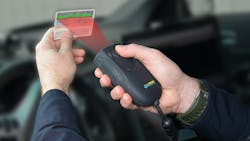The Intersection of Officer Safety and Filling Out Your Reports
There is no normal day for a law enforcement officer. There is no normal, "typical", just your average run of the mill day-to-day traffic stop. There's a saying that goes something along the lines of, and I can't remember who uttered this wise thought, that an officer should treat every situation as if it's the most important of their career—because it very well could be.
What we need are officers looking forward at the car in front of them during a traffic stop, watching the passengers, and not twisted to the side with attention and eyes away from the scene.
Today's law enforcement officer has a ton of technological solutions and digital products available at their fingertips. From brand new smartphones like the Samsung Galaxy S10 and the Sonim XP3, rugged tablets like the Durabook R11 and the many versions of the Panasonic Toughpad, to the ever-evolving world of wearable products like body cameras—not to mention the technological advancements coming into the patrol car's engine. If one looks hard enough, there's a solution that looks to aid an officer's job.
With that in mind—apart from the latest and greatest form-creation records management system software your agency may need—let's look at two technologies aimed right at one of the more mundane parts of police work: filling out your reports. Surprisingly enough, the concepts behind these seemingly simple solutions is so straight-forward, there'll be little surprise if they became a common fixture in the patrol car of the future. In the end, their intuitive nature can even increase officer safety.
Two ways to capture data
There are available ways to cut the actual pen and paper out of paperwork, e Citation (a.k.a. electronic ticketing or eTicketing) does just that. Based on data provided by L-Tron Corporation, if it takes an officer an estimated 12 minutes to write up a single citation e Citation can save 75% of that time. Accumulating that throughout the year, multiply that by how many times our nation's patrol officers pull over someone on the roadside—let's just say it's a lot of time saved at the end of the year. Not only that, but the time saved at the moment allows that officer to be more aware of their surroundings and increase situational awareness.
While e Citation can cut the pen, now you're stuck typing. Recent innovations have developed clever solutions on how officers actually enter data into their reports. What we need are officers looking forward at the car in front of them during a traffic stop, watching the passengers, did they just throw something out the window? and not twisted to the side with attention and eyes away from the scene.
One company developed a tool to capture the data from driver's license cards instead of manually typing their name, address, driver's license number, etc, and hoping to get it all correct first try. Make sure to double check each ... and ... every letter and number. L-Tron's 4910LR is a handheld license reader and camera roughly the same size and shape as your lapel mic with a single purpose of capturing data and populating the appropriate fields on your reporting system forms.
The device also includes a gray-scale camera/image capture scanner to help capture supporting images or documents like signatures, sketches, and even photos. Since the 4910LR connects via a USB, it should work with nearly any computer and mounting system found inside a patrol car. A strong magnetic mounted version can be purchased to help place the 4910LR where you need it. One of the most common places, Rad DeRose, President of L-Tron Corporation noted, is the side of the dash—accessible, easy to reach, but out of the way.
Now that the card is scanned and vital data has been automatically populated into your report, you now have to describe the situation. Keep your eyes forward and your attention away from that keyboard with voice recognition. We're not talking about Siri or Alexa here, but a software that is able to, well, take dictation (and more) for lack of a better word.
Nuance Communications began in the healthcare sector where doctors use voice recognition software to aid medical professionals to add information to a patient's file. Later, in 2016, they branched out to the law enforcement market and released Dragon Law Enforcement and allowed officers to basically talk to their computers directly.
In the simplest of terms, Dragon Law Enforcement provides a speech-to-text solution wherever the cursor may be with 99% accuracy. However, it's not out-of-the-box software. Each officer will have a unique profile matched to their voice, which can be either stored on the machine itself or on the cloud. Agencies can opt for an always-on system activating it with commands like "Dragon go to sleep" or "Dragon wake up" or push a button to start the software going. Aiding this is the Nuance Power Mic (now on its third iteration). While any good quality microphone should work, the Power Mic is a noise-canceling microphone that works much like a CB handheld; turn it on and talk. As you may very well know, the police vehicle can get loud and the noise-canceling feature is key—Nuance says that the Power Mic's accuracy is still high even in noisy environments such as blaring sirens or a blasting AC. A hands-free version is being tested.
Apart from typing for you, the software can also be used to control various systems. In one example, VP and General Manager of Dragon Professional and Consumer of Nuance Communications Mark Geremia explains that some agencies have set up the system to work with special commands where "log me in" can start up five different applications and save about 20 minutes of the day.
Updates are being made constantly. Dragon Law Enforcement's engineering team work hard to make sure the system can integrate seamlessly current records management systems. With a powerful command control, Dragon puts your entire system right at the tip of your tongue. Commands like "open Microsoft Word", "underline that", "go to [field]", "submit and create a ticket", or "do a license plate lookup" will all work once set up.
The combination of the 4910LR and Dragon Law Enforcement has all but made filling out an incident report, or e Citation for that matter, as hands-free as current technologies allow. With so less manual labor, Nuance hears that customers were creating higher quality, more detailed, longer—more than tripling the length of previous manual efforts in some cases—and on time incident reports.
When it comes to it, one can boil both of these down to two simple advantages: 1) both keep an officers attention open, less time focused to the screen, and 2) less time creating reports on the road means less time on the road. With the roadside as dangerous as it is, that's something we all can appreciate.

Jonathan Kozlowski
Jonathan Kozlowski was with Officer.com, Law Enforcement Technology, and Law Enforcement Product News from August 2006 to 2020.
As former Managing Editor for Officer Media Group, he brought a dedicated focus to the production of the print publications and management of the Officer.com online product and company directory. You can connect with Jonathan through LinkedIn.
Jonathan participated as a judge for the 2019 and 2020 FOLIO: Eddie & Ozzie Awards. In 2012, he received an APEX Award of Excellence in the Technology & Science Writing category for his article on unmanned aerial vehicles (UAVs) in police work, aptly titled "No Runway Needed".



